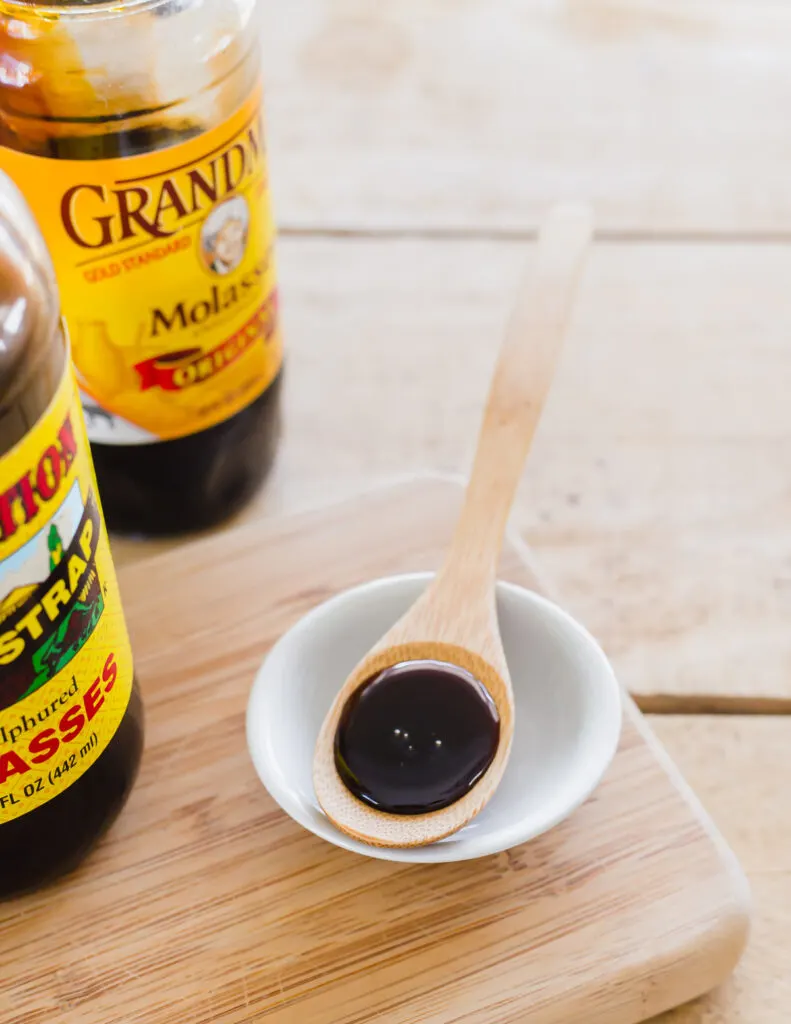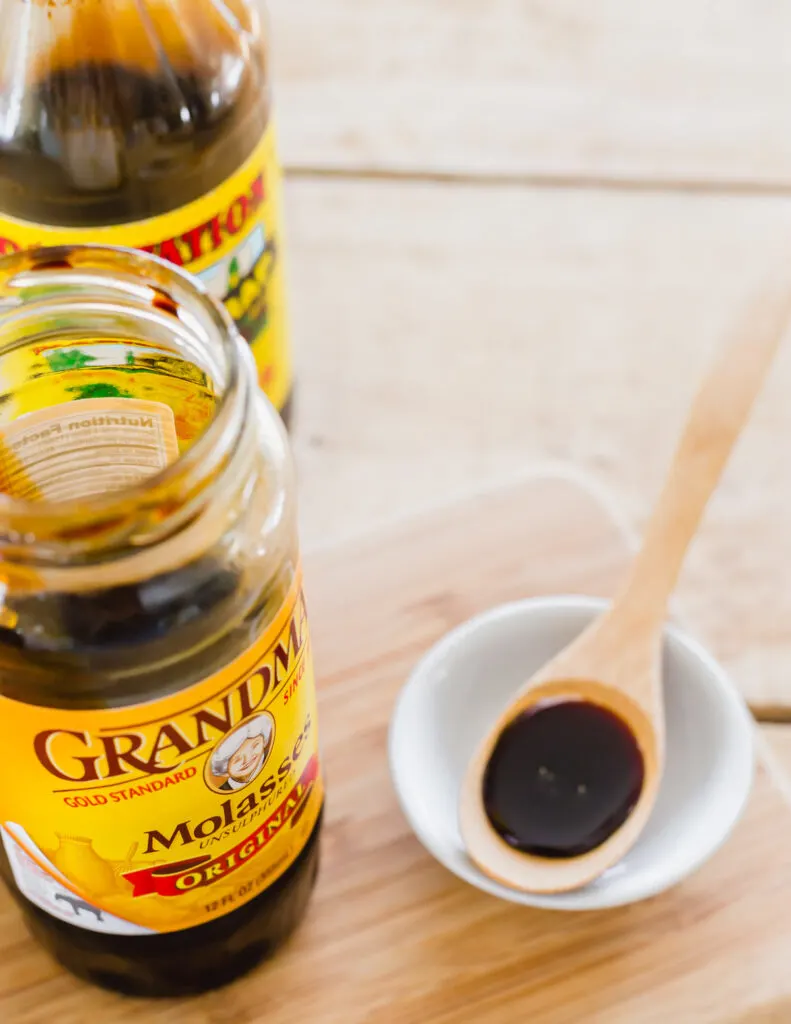As a popular natural sweetener and flavor enhancer often used in baking (fancy some gingerbread cookies?), you may be wondering if your dog can also enjoy molasses either in their food or baked into a homemade natural treat.
Read on for everything you need to know about molasses and your dog!

CAN A DOG EAT MOLASSES?
Let’s cut to the chase – yes, dogs can eat molasses.
There’s nothing inherently bad or toxic about molasses as it pertains to dogs so long as the molasses used doesn’t contain any added ingredients or artificial sweeteners such as xylitol which can be toxic to dogs.
As usual, even something natural like molasses should be given in small amounts if you decide to include it in your dog’s diet.
WHAT IS MOLASSES?
Molasses is a natural sweetener that comes from cane or beet sugar. While not as popular in the U.S., it’s often consumed in the UK and sometimes even given to children because of its nutrition profile. More on that below.
Sugar cane or sugar beets are crushed in the sugar making process. The juice is extracted and then boiled down to make sugar crystals.
Molasses is the thick, dark syrup that’s leftover after the sugar has been removed from the juice.
This process can be repeated several times, each time producing a different type of molasses which we’ll discuss below.
TYPES OF MOLASSES
There are many different kinds of molasses, the two most common brands found in the grocery store are pictured here.
When it comes to choosing a molasses to incorporate into your dog’s diet, we recommend ensuring it is the “unsulphured” type.
Sulphured molasses has sulfur dioxide added to it to act as a preservative.
It’s also a cheaper and quick way for manufacturers to make younger sugar cane taste more like mature cane through the addition of chemicals rather than added processing.
LIGHT MOLASSES
Light molasses is also referred to as golden, regular or original molasses. Sometimes even “treacle”. This type comes from the first boiling and is lighter in flavor and color.
Its flavor is tamer than dark or blackstrap molasses so it may be more palatable to your pup like it is for humans.
That said, its high sugar content makes it so that it should only be used sparingly if you choose this type for making homemade dog treats.
The “Grandma’s” brand shown in the picture here is an example of light molasses and indicative of what you’ll most often see on the store shelves.
It’s used in baking for cookies, muffins, cakes and sometimes even granola.
DARK MOLASSES
Dark molasses comes from the second boiling of the sugar beets or sugar cane in an effort for manufacturers to extract even more sugar.
What’s leftover is even darker than the first boiling and less sweet.
Its flavor is much more intense but it’s nutrient profile is also more impressive.
Dark molasses is oftentimes used in savory dishes instead of desserts (it’s a great ingredient to a homemade BBQ sauce recipe!).
BLACKSTRAP MOLASSES
You guessed it, blackstrap molasses comes from the third boiling and has the most bitter taste of them all.
It’s also the most nutritionally beneficial often being used for the high amount of iron it contains.
Blackstrap molasses has a very low sugar content so while humans typically shy away from this variety unless used for depth of flavor in seriously savory dishes, it’s commonly understood to be the best type of molasses to give to your dog.
Dogs suffer from a disproportionate amount of obesity (much like humans these days) so monitoring the added sugar given to your dog is important.

HEALTH BENEFITS OF MOLASSES FOR DOGS
While all types of molasses have similar nutritional content, blackstrap is recognized as having the most health benefits.
With the least amount of sugar, lots of iron (used often to control the risk of anemia) and lowest amount of calories, it’s the variety best suited to feeding dogs.
Molasses is also a natural source of vitamin B6 as well as minerals such as magnesium, calcium, potassium and phosphorous.
The calcium can help maintain healthy bones decreasing the chances of osteoporosis in your dog.
Another beneficial component found in molasses is chromium. Studies have shown how this compound has helpful glucose moderating effects and can help maintain healthy blood sugar levels.
If your dog suffers from diabetes, molasses could therefore be a useful dietary supplement.
Rich in polyphenols, molasses is also a great antioxidant as well which means it contains anti-inflammatory properties.
HOW MUCH MOLASSES CAN I GIVE MY DOG?
Small quantities of molasses can be a healthy option for your dog. Serving size should be limited based on the size of your dog.
A maximum of about a tablespoon is usually a good reference point for an average sized dog.
There’s no need to make molasses the star ingredient in your dog’s pet food but if you’re considering a holiday themed treat for your furry friend, take comfort in knowing this is a safe ingredient to use in small portions.

HOW TO INCORPORATE MOLASSES INTO YOUR DOG’S DIET
These are adorable dog treats made with blackstrap molasses and coconut oil (coconut is safe for dogs to eat, including the oil) your pup will likely love!
You can also find commercial dog treats that use molasses as a natural sweetener with a little bit of research.
Beyond baking into a healthy treat, if your dog will tolerate the taste (don’t be surprised if they don’t!), you can spoon a little into their regular food.
Swirling it into applesauce or something else like a dog safe nut butter is a good idea to help mask the natural bitterness.
It’s often paired with pumpkin in baked goods which is another ingredient that’s both safe and healthy for your dog.
